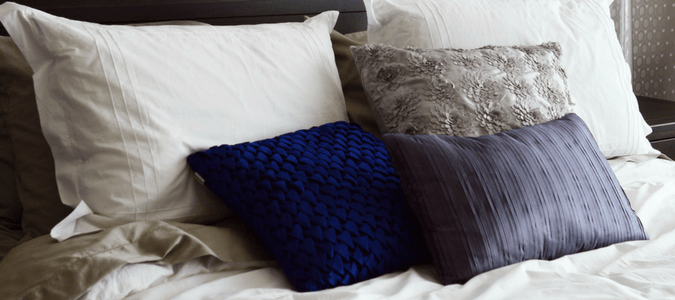
The last line from a children’s rhyme,“Don’t let the bed bugs bite!” can become all too real when bed bugs infest your home. Bed bugs are becoming more common as populations grow, travel increases and the bed bugs spread to new areas. Learn how you get bed bugs and what you can do to prevent them.
How You Get Bed Bugs
You may have only heard of bed bugs from the children’s rhyme, or from recent new reports about bed bug infestations in cities across the country. It may not seem like a big problem, but several U.S. governmental agencies, including the Environmental Protection Agency (EPA), the Centers for Disease Control (CDC) and the Department of Agriculture (USDA), have declared bed bugs as a public health concern, even though bed bugs do not spread disease the way ticks and mosquitoes do.
So, what should you know about these pests? Where do they live? How do you get rid of bed bugs? Let’s answer some of the most common questions homeowners have about bed bugs.
What are bed bugs?
Unless you’re bitten, you may never see a bed bug, or you might assume it’s something else. Bed bugs have small, flat, oval-shaped bodies, about the size of a pencil eraser. They can’t fly, but they can move like a flash, as they crawl over floors, walls and ceilings.
Under the best conditions, bed bugs develop from egg to maturity in a month. Female bed bugs lay hundreds of eggs over a lifetime, and three to four generations of bed bugs can be produced in just a year.
Like ticks, bed bugs feed on blood, needing to fill up before they can grow, so each stage of their lives ends with a big feast. And, like ticks, most bed bugs die before reaching maturity because they can’t find enough food sources.
Where do bed bugs live?
You’ll find bed bugs everywhere; they’re not limited to one region of the country, one area of the world. Bed bugs live wherever there are warm-blooded animals and humans. These pests spread mainly through contact with another location that already has a bed bug problem. Luggage, handbags, clothing, used beds and couches are all pathways used by bed bugs to get from one place to another.
Once in a home, bed bugs like to live in cool, dark places close to their food source. Since they can flatten their bodies to the width of a credit card, it’s easy for bed bugs to hide in mattresses, box springs, bed frames and headboards.
Contrary to popular belief, bed bugs do not need dirty surroundings to thrive; bed bugs are opportunists, so even the cleanest home, hotel room, office or restaurant can have bed bugs.
What are signs of bed bugs?
You may never know you have a bed bug problem. Most people who wake up with little welts on their arms, legs and other exposed areas of skin assume the bites might be from fleas (if they have animals), mosquitoes or spiders. If you recently purchased a used mattress or box spring or traveled to a city where bed bugs are a problem, you may have a bed bug problem. Other signs of bed bugs include:
- Small blood stains on your sheets or pillow cases
- Dark or rusty spots on the sheets, carpet or walls near crevices
- An offensive musty smell
Of course, the best way to really know if you have bed bugs is to see them crawling around. If you suspect bed bugs, they may not limit their hiding places to your mattress or box spring. Be sure to also check in and around:
- Seams of chairs and couches, between cushions and in the folds of curtains
- Drawer joints
- Electrical outlets and appliances
- Where the wall and ceiling meet
- Any small tiny, thin and protected spaces in your home
- Purses, luggage and briefcase
How to get rid of bed bugs
It’s best to treat a possible infestation of bed bugs while it’s still small. That said, bed bugs can be extremely difficult to control on your own, so it’s best to bring in an expert to identify the source of your problem and start a treatment regimen. There are a few things you can do on your own before calling in the professionals:
- Clean bedding, linens, curtains and clothing in hot water and dry them on the highest heat setting on the dryer to kill both mature bed bugs and eggs.
- Treat stuffed animals, shoes and anything else that can’t be washed should be run in the dryer for 30 minutes on high heat.
- Scrub the mattress, box spring, couch cushions and other areas with seams with a stiff wire brush to remove the bed bugs and their eggs.
- Vacuum the bed and surrounding areas frequently.
- Use hypoallergenic mattress and pillow covers.
- Get rid of clutter around furniture.
Even after you have treated your home for a bed bug infestation, these little creatures can return if you aren’t careful. Avoid buying second-hand mattresses, couches or chairs and regularly inspect items you bring into your home after trips or from resale shops to prevent bed bugs from coming back.
ABC Can Banish Your Bed Bugs
Don’t panic if you suspect you have a bed bug problem; it’s not a sign you’re a poor housekeeper or you live in an unclean area. That said, bed bugs are often extremely difficult for homeowners to handle on their own. ABC can conduct a thorough inspection of your home to identify exactly what type of pest has made its way inside and outline the best course of action for treatment. With the help of ABC, you can enjoy a pest-free home.
